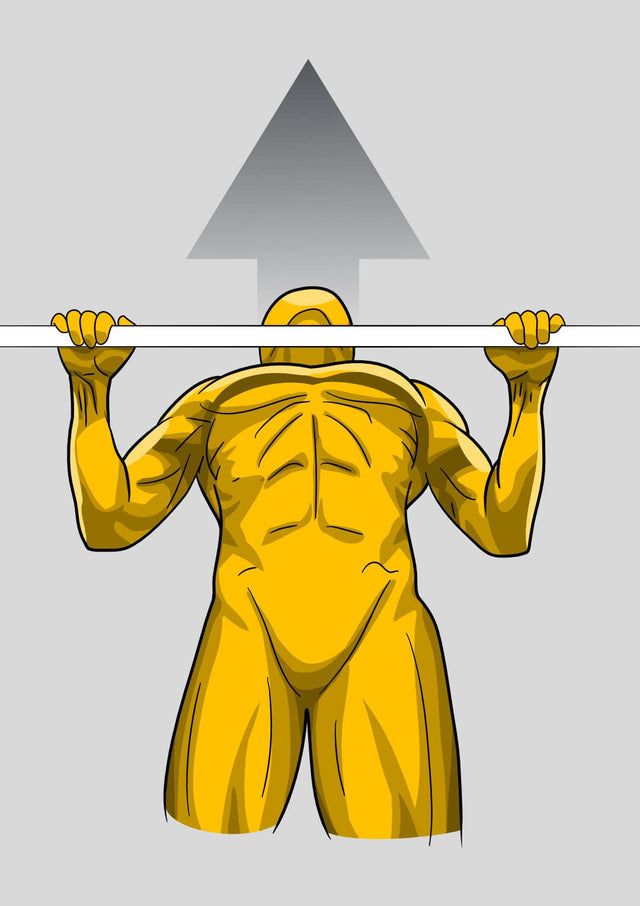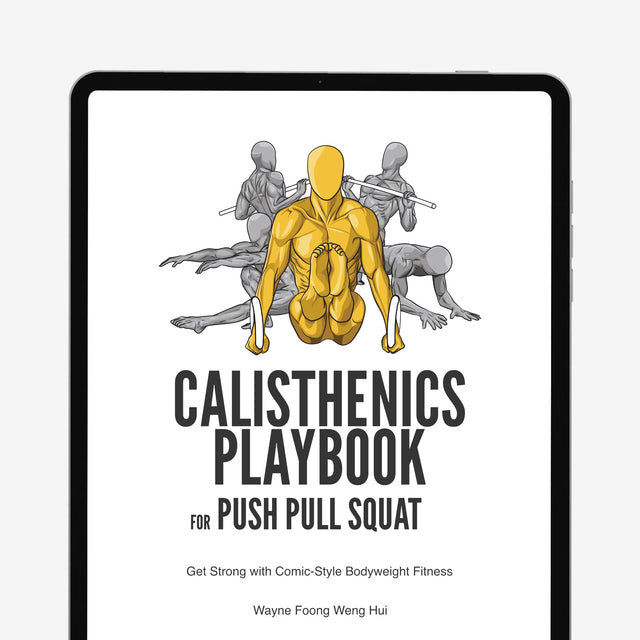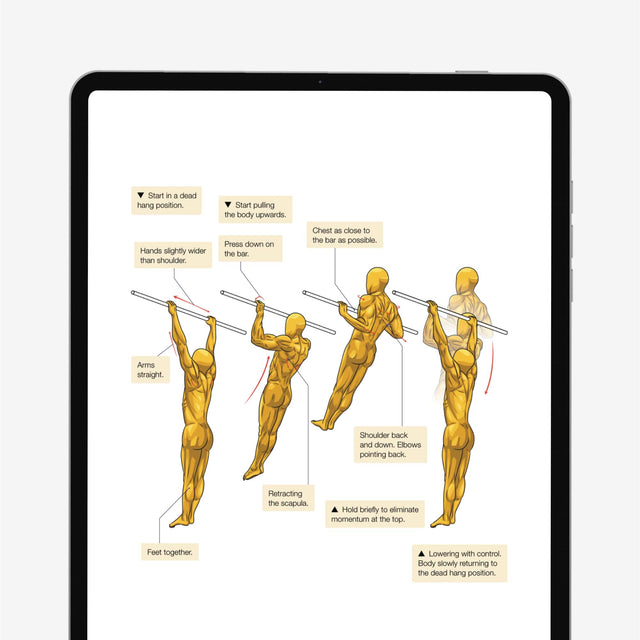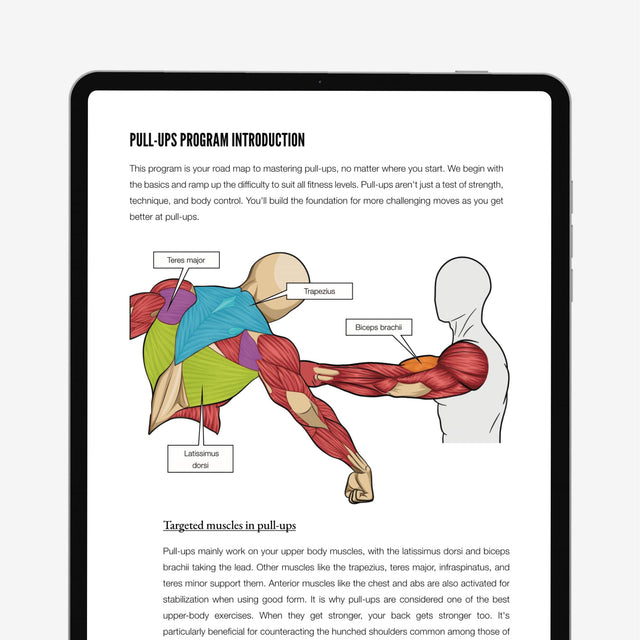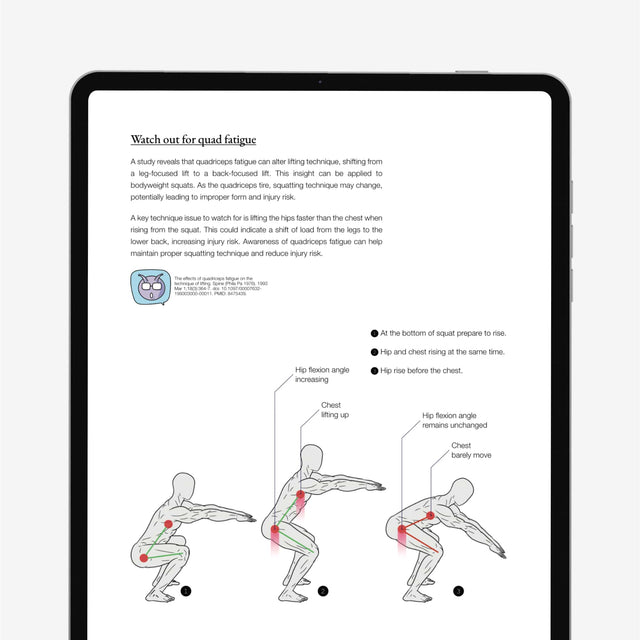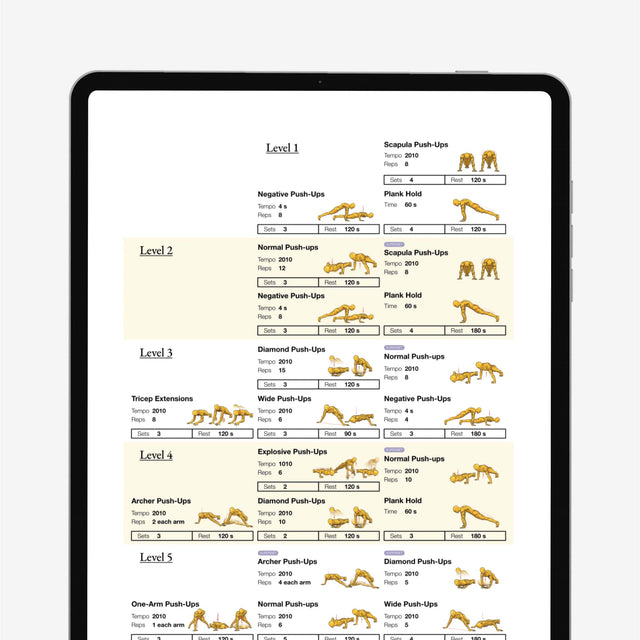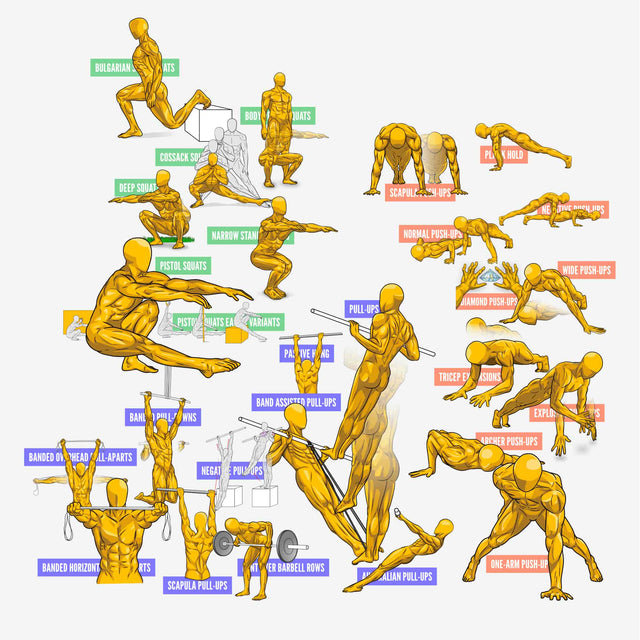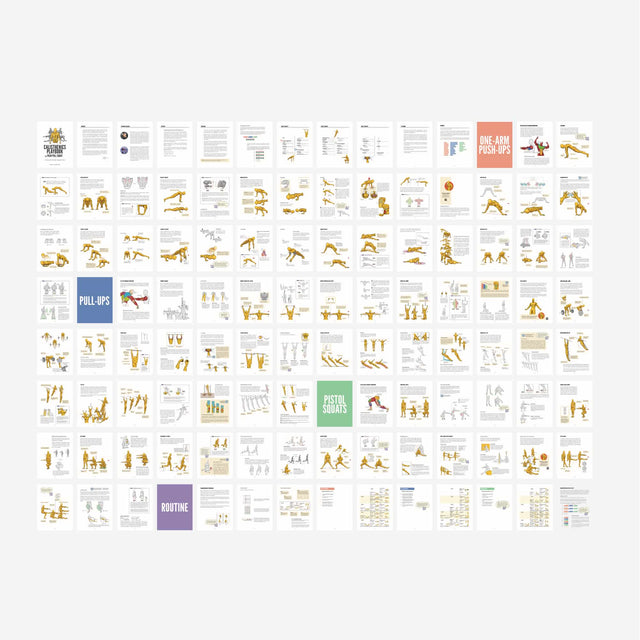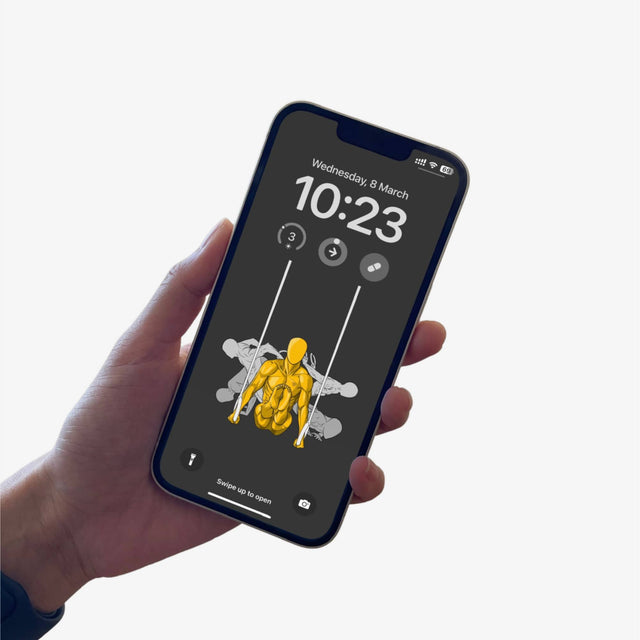The Only Guide You'll Need for Perfect Pull-Ups (with Game-Changer Illustrations)
A perfect pull-up is not just about doing your best to lift your chin over the pull up bar. A good pull-up means that you are using the right muscles, pulling at the correct angle, and keeping your core tight throughout.
This article will teach you the most effective ways to do a perfect pull-up so that you can get the most out this awesome upper body workout.
- What is a perfect pull-up?
- Why is doing a perfect pull-up important?
- How to do a perfect pull-up?
- Tips for doing a perfect pull-up
- Common mistakes and how to avoid them
- What muscles need to be strong for strict pull-ups?
- How to do pull-ups for beginners?
- Pull-up alternative
- Pull up grip type
- Pull up grip width
- FAQ
What is a perfect pull-up?
A perfect pull-up is a full range of movement, meaning you can completely lower and raise yourself, with full range of motion, without using momentum. It can be done on pull up bars or gymnastic rings.
Why is doing a perfect pull-up important?
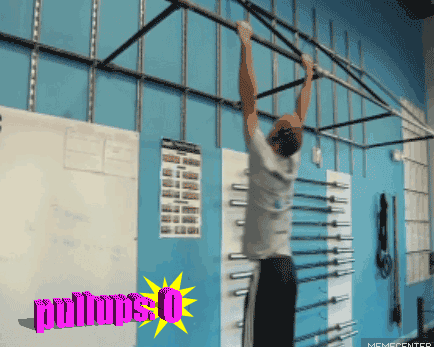
This is the classic butterfly pull-up from Crossfit. I'm not trying to flame the kipping pull-up as useless, this technique are for maximizing the pull-up number in competition. But they are not good for gaining the real strength in the pull up game.
The perfect pull-up is all about keeping the body straight and avoid swinging. This means that you are using the right muscles such as lats, biceps, core muscles to execute this movement instead of just relying on gravity or momentum.
Perfect pull-ups build functional strength that gets to transfer well to other advanced strength training skills such as muscle-ups, back levers and front levers. You are not going to learn those skills by cheating on your pull-ups.
Doing pull up regularly with correct techniques ensures a sustainable and injury-free journey. Else, it tends to stress your joints and muscles in an unnatural way. This can lead to a fitness plateau or even worse, injury.
How to do a perfect pull-up?
This is how a single rep of pull-up with perfect form looks like:

- In the start position, grab the bar with overhand grip to form an active dead hang position by rolling the shoulders back and down. Grip the bar with shoulder width or slightly wider. Elbows locked, arms fully extended, and core engaged.
- Keeping elbows pointing to your waist, pull yourself up explosively until your chin is above the pull up bar.
- Hold for a moment and feel the squeeze in the back.
- Lower down in a controlled manner and spend at least 2 seconds coming down. There should be no swinging of your body or sudden release until your arms are fully extended.
Tips for doing a perfect pull-up
Engage core all the time
Study shows core are what involved the most in pull-up. Surprised? No need to be. Keep the core tight throughout the full set of pull-up and you will know why it make so much sense in doing so.

Fully engaged core keep our body stabilized and not wasting the energy by swining around. You will be able to foucs the energy on the actual movement and perform more reps with better quality. Even better, you might be hitting more reps!
Straight legs with toes pointing down
Too many online videos about pull-up showing people doing pull-up with their legs crossed and behind their body. Not good.

A good posture of pull-up should be like an arrow with the legs straight. This goes particulary well with our previous tips, which is engaging the core. With straight legs and tight core, your body will form a straight line from your shoulder to the toes. And the only moving part should be your back and arms.
Grip the bar right
Finger knuckles should point to the sky instead of sideways when you hang from the bar. Your palm should form the biggest contact area with the bar. This way, you can have a stronger grip strength and avoid hand fatigue.

If you are using gymnastic rings, use a false grip. The idea is to place your wrists over the rings instead of under.
If you have your grip right, one obvious sign is your grip should not slide or loosen up in a single set of exercises. If it does, you are not holding the bar tightly. You might use products like liquid chalk to increase the grip friction.
Elbows point to the ground
To fully engage the lats (the most important muscle in doing pull-ups), elbows need to be kept closer than 45° relative to our torso. While pulling up, keep them pointing to the ground as much as you can.

You might also find this is easier to do by placing your elbows in front of your body. This technique transfers your pulling strength very well to the muscle-up.
Hit bar with chest
When you pull up, the common practice is to hit the bar with your chin. Hit it instead with your chest as if giving a kiss. Why this is a better goal? Because to hit the bar with the chest, you will have to pull explosively and squeeze your lower traps hard.
So it automatically forces you to use the correct form since the beginning or optimal gain.

Use your back muscles
Many people make the mistake of not using their back properly during a pull-up. They imagine themselves pulling with chest and biceps only, which is wrong!
Think about squeezing shoulder blades together as if trying to pinch a coin between them at the top position on the bar. Your shoulder blades should be pressed down as much as possible. Another way to look at it, is your shoulders should be away from your ears.

This is going to target the lower traps which is normally hard to target. And it engages your whole back muscles better which can be transfer to harder pulling exercises like front lever.
It is normal if you cannot do this for the first time, because our lower traps are generally weaker. Try with an easier progression such as body row.
Common mistakes and how to avoid them
Forget to breathe
This is another common mistake people make during pull-up. Many are holding their breath or breathing erratically because they feel it helps them to do more reps with better quality.
But this is wrong with most exercises. We need oxygen all the time in order for our body and muscles to work at their best performance level. If you do not breathe properly, your muscle will burn out faster and you risk fatigues way earlier than you should.
So just remember to always take a breath with every single rep of pull-up. Do so before coming up or down depending on the progression level. Keep breathing at all times during exercise even when it is hard for you.
Using momentum
Some people make the mistake of using their momentum to pull up when they cannot do it properly. This is not a great idea because you will only learn bad form and in return, increase your risk for injury later.
If you feel like swinging and kicking around to complete the move, this probably means you are not ready yet. Train easier progression skills more for the necessary strength. Then, after you master some easier progressions smoothly, try to do them without any swing or kicking.
Not doing the full range of motion(ROM)
Many people only go halfway up when doing a pull-up. This is because they are not strong enough to do it fully or their body simply cannot lift the full range of motion yet.
We tend to avoid going to the extreme end because our muscle ability to exert force is weakest, at the shortest and longest muscles length. However, this is exactly the reason why we should always do full ROM for the max gain.
You are leaving a lot of gain on the table if you do not go all the way up and down.
Not resting enough between sets
Pull-up is very much a strength workout and a strength workout needs to be performed with the most refreshed status.
In order to maximize your strength, you need to rest enough between sets so that the muscle can recover fully and be ready for another set of exercises with maximum intensity.
If you do not take a break during a pull-up, chances are high your form will drop second after second and you are starting to teach your body the bad form.
Rest at least 2 to 3 minutes between sets and perform every rep with perfect technique.
Gripping too wide
A grip that is slightly wider than shoulder-width, targets more on the back muscles. But if you are going too wide, the range of motion will be limited. And you will be putting too much strain on the shoulders.
The wide grip also tends to reduce what biceps can do. When you grip too wide, your elbows are pointing outwards and biceps cannot contribute to the pull-up as much. Some other weaker muscles are forced to take over the stress and if they are not ready yet, injuries are likely to happen.
What muscles need to be strong for strict pull-ups?
Back muscles

Lats, mid & lower traps are some of the main muscles that needs to be strong for pull-up. These back muscles will have a major role in strength building and keeping you safe from injuries when doing this exercise.
Biceps

The main driver in the arms when doing pull-up is the biceps brachii. It will be responsible for most of the movement involving the shoulder joint, especially during elbow flexion at high angles when performing this exercise.
Core muscles

Another muscle that is very important for pull-up strength is the core. Your abs, obliques, and lower back help a lot in keeping the body in good form during this exercise so it can be performed with perfect technique.
Forearms

Forearms also play a big role in pull-up strength. It is important to have strong forearms and grip because your hands will be holding onto the bar during this exercise.
How do beginners do pull-ups?
There are many progressions for beginners to achieve their first pull-up. Even if you already can do pull up, these progressions are still very useful as they help you to do more pull-ups.
Check out the easier variations below to gain the fundamental upper body strength for a full pull-up.
Pull-up alternative

- Assisted pull-ups with a resistance band are one of the best exercises for beginners because they introduce them to the movement pattern of a pull-up while reducing strain on your joints. Reduce the band thickness as you grow stronger.
- Chin-up is a lot easier than pull-up because you are gripping the bar with palms facing towards your body. This means that forearm and bicep muscles have more involvement in chin-up than back muscles. Chin-ups can be used as an alternative to working for a full range of motion on a regular basis.
- Kipping pull-up is great in learning the hip drive that will be used in more advanced pull-up variations. Swinging and kipping help to build strength in the hip flexion/extension pattern needed for a full body weight pull up.
- Bicep curls with dumbbells are probably the most effective weight exercise you can do to level up your pulling strength. Dumbbells allow you to strengthen the muscle through different angles and movement patterns which will make it more functional for real-life application.
- Negative pull-ups are excellent for beginners to learn the eccentric contraction of a pull-up. This exercise also help you build up strength endurance in your upper body so that doing full ROM will be much easier when you are ready.
- Dead hang works wonder for your grip strength. Grip the bar right and stabalize as much as possible using core and shoulders. Resist the grip from loosing up. If you can hang still for 1 minute straight, do it with L-sit position for more difficulty.
The list goes on. We've made a detailed article on pull-up alternatives in case you need more options for getting started.
Pull up grip type
There are 3 types of grip that are commonly used when doing pull-up.
Overhand grip

This is the one you are supposed to use in pull up. Your hands are facing away from you when doing pull up so that your palms face towards your body. This grip put more emphasis on the back.
Underhand grip

Turning your palms are facing towards you when gripping onto the bars makes it a chin up exercise. This is easier as it reduces the stress on your lats and allows stronger muscles like biceps to take over.
Neutral grip

When using this grip, both palms are facing each other. A neutral grip is the most comfortable grip as it put our wrist at the most natural position without twisting it like overhand grip does.
Pull up grip width
How far apart is your grip on the bar affects the muscles involved in this exercise.

Shoulder width grip
This is the most popular grip width for pull-up. Using shoulder-width grip helps to develop your middle upper back muscles and biceps more than other variations because it allows you to use a full range of motion with less stress on joints.
Narrow grip
Close grip pull-ups put more emphasis on elbow flexors which is not the main target in a regular pull up exercise. This variation of pull up also works your biceps harder than usual because it puts them under tension for a longer period of time due to close grips.
Wide grip
Using a wider than shoulder width grip will place more emphasis on the lats and upper back which can be useful for developing lat strength and size. This variation of pull up is also great at working your core stability by forcing you to contract it throughout the movement like we have mentioned above.
FAQ
How to do pull-ups at home (without a bar)?
The best option is gymnastic rings. You can install a mounting point on the wall or ceiling. Recommended width is 50cm apart. Or you can hang the rings on tree branches.
There are some pulling exercise with a resistance band that can hit the same muscles as pull-ups. Anchor the band around something sturdy, such as doorknob or post. Stand firmly with a bend knee, and start pulling the band. Your shoulders and back should be the only moving parts. Use thicker bands or stand further from the anchor point for more challenge.
Looking for tree branches or monkey bars outdoor is also a very good option.
Do pull-ups give you a six-pack?
There is no magic exercise that can give you six-pack by itself. Pull-ups and other kinds of bodyweight exercises do burn fat, but the real work is in the diet.
Pull ups required a lot of engagement from the core, it does help build lean muscles mass. But if you are eating too many calories, those are going to end up fat around your belly.
To lose weight you need to eat less than your daily calorie expenditure, which means cutting down on junk food.
Is it possible to do 100 pull-ups in a row?
Yes, it is definitely doable. But it doesn't mean you should go for it, unless your goal is to set a record or something.
Going for strength is always the better goal. The moment you can do over 20 reps of pull up effortlessly, is the moment you should start focusing more on your technique, than the number of reps.
For example: if you can do 30 pull-ups but they are not clean and with bad form, then keep working until you get them perfect. Then try to go for 20 strict pull up instead.
Weighed pull-up is a great way to make your pull-up harder so you can reap the biggest gain in strength and hyperthrophy. Weight vest or dip belt is generally the good option for resisted pull-up.
Do pull-ups give you bigger arms?
Yes, they do give you bigger arms.
It is not because you are doing pull-ups that this is happening though. It's more about the fact that all pulling exercises work for your biceps and triceps muscles. Pull up also works on back muscle to a certain extent, but most of the building comes from shoulders (like with most bodyweight exercises).
Chin-ups and pull-ups, which one is better?
Chin-ups is easier to perform than pull-ups. Mainly because chin-ups use more of the stronger biceps in the pulling action. Both exercises hit the back muscle the same. That's the reason chin-ups often were used as a stepping stone to gain strength for first pull-up.
Pull-ups is performed with palm facing away from the face. And that's the only difference. This workout also serve as the golden standard to judge one relative strength. Here is an interesting write-up about chin-ups vs pull-ups if you want to learn more.
Do bicep curls help with pull-ups?
Yes, bicep curls help with pull-ups.
BIceps are responsible for generating the strongest pulling force when you are doing pull-ups. This is why chin-up is much easier than pull-up, because chin-up uses more of biceps due to the supinated grip.
Building strong biceps will help you with your pull ups, no matter how your train them. Probably not 100% of your bicep curls gain are going to transfer to pull up. But having stronger biceps definitely will help.
Should you do pull-ups fast or slow?
During the pull from the bottom to the top position, it should be explosive and fast. The explosiveness makes the pulling easier and the force can transfer well to muscle-up down the road.
On the other hand, you should do it slowly on the descent phase. Come down slowly as if there is a string attached from the top of your head which pulls you back downwards very gently until reaching the dead hang position again. It will help with building strength faster.
How many times a week should I do pull-ups?
You should do pull-ups every day for a couple of reasons.
Your back is a huge group of muscles and it is too strong to be overtrained. So you can do it every day, as long as you have enough time and energy.
In order to increase the strength of your back muscles, you need to work them frequently so that they adapt to the stimulus. It is better if this happens on a daily basis rather than doing occasional heavy sessions once per week or something like that.
It is true that you can't grow muscle if you don't provide your body with enough time to recover and rebuild itself (otherwise it would be like working in a factory). But still, the stronger you become at doing them the more often they will need to be done.
Only one caveat if you are doing pull-ups every day, that is don't go to failure every set. Try to stop at least one or two reps before failure. If you are doing more reps than your max, it means that the quality is bad and this might lead to overtraining or injury if done too many times per day.
What are the hardest pull-ups?
One arm pull-up is the hardest pull-up. It requires a tremendous amount of strength and focus. What makes this even harder is to perform with both of your arms. Because pulling this trick off your non-dominant arm is a lot harder than doing it with your dominant arm.
Muscle up is the second hardest, due to the fact that you start from a full hang position (which requires more strength). Some might argue muscle up is not pull up but a mix of pull up and dip. However, this exercise demonstrates the significant explosiveness of your pull up ability.
Can gorilla do pull-ups?
Pull-ups to a gorilla is as easy as walking to human. They are made for pulling and do everything with their strong arms.
Gorillas are heavy animals that spend most of the time in trees swinging from branch to branch, grabbing fruits and leaves. They also use their long arms for hanging down when they feel tired or just want to relax a little bit. It's not rare at all to see gorillas doing pull-ups in zoos around the world!
Can babies do pull ups?
Pull up ability depends on one big factor that many seem to neglect. That is the lighter you are, the easier you are going to lift yourself up. Simple physics.
So the answer is yes, babies can perform pull ups. You don't have to be an adult with fully formed muscles to perform pull-ups. We've seen a dozen of online videos that children around 3 to 5 years old are doing pull-ups easily, under the supervision of adults of course.
However, just because they can do it doesn't mean they should do it. We are not sure what the consequences will be if they were to do them regularly at such young age. You should keep in mind that you don't want to rush your kids into doing things too fast, especially when it comes down to physical activity and exercise.
Start doing perfect pull-up today
Quality is everything. Even if you do one perfect pull-up with the strict form it will help your strength and ability to perform them more times with crappy form.

